| Home |
|
Bore Surfing |


|
||||

|

|
|||
|
|
|
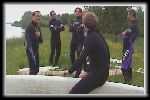 At the current time four of the world's bores are surfed, and several others are being investigated. However, there are not more than twenty surfers worldwide that ride their respective bores regularly. Crowds can amass, but they soon disperse again and it is the local surfers that still remain.
At the current time four of the world's bores are surfed, and several others are being investigated. However, there are not more than twenty surfers worldwide that ride their respective bores regularly. Crowds can amass, but they soon disperse again and it is the local surfers that still remain.
The river becomes their local surf break and they study it like any resident surfer would, learning the channels, where the banks are, what happens under different conditions. But the fascination grows deeper. The ebb and flow of the tides and the passage of the moon can also compel the bore surfer to learn more.
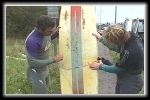 The philosophy of the bore surfer has its roots grounded in the original malibu surfing ethos. The concept of connecting with the wave, becoming part of the wave. This is where understanding leads - being able to move with the wave freely without thought. So the skill in bore surfing is not just being able to ride the wave but knowing what is going to happen next, where the wave is going to break. Taking the opportunity for manouveres when face is offered but retreating back to the critical shoulder at the right time.
The philosophy of the bore surfer has its roots grounded in the original malibu surfing ethos. The concept of connecting with the wave, becoming part of the wave. This is where understanding leads - being able to move with the wave freely without thought. So the skill in bore surfing is not just being able to ride the wave but knowing what is going to happen next, where the wave is going to break. Taking the opportunity for manouveres when face is offered but retreating back to the critical shoulder at the right time.
But these skills can not be learnt, they can only be developed over time. The rivers constantly change, banks shift, flows vary. This keeps a constant stream of excitment and anticipation flowing through the bore surfer unknowing of what the next tide could bring. Add to this the thrill of the chase, by van or car, to again get in front of the tide and have another attempt, the fulfilment of discovering a new break, and the sheer stoke of surfing among scenary and wildlife so very removed from the coastlines, then the bore experience is complete. This is what bore surfing is all about...
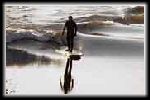
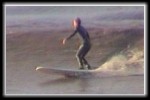 Over the next thirty years, surfers have come and gone. Firstly pioneers of surfing Britain would tackle the bore then, as media attention grew, periods of exceptionally large tides saw crowds of people heading for the river. But in all this time, and through all the frenzy, two local river men, Dave Lawson and Steve King, concentrated on learning the river and developing an understanding and connectedness with the bore. So, the local bore surfer was born, and the years truly paid off, as they both dominated the sport, surfing distances in excess of five miles.
Over the next thirty years, surfers have come and gone. Firstly pioneers of surfing Britain would tackle the bore then, as media attention grew, periods of exceptionally large tides saw crowds of people heading for the river. But in all this time, and through all the frenzy, two local river men, Dave Lawson and Steve King, concentrated on learning the river and developing an understanding and connectedness with the bore. So, the local bore surfer was born, and the years truly paid off, as they both dominated the sport, surfing distances in excess of five miles.
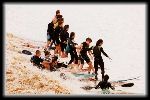 Then at the turn of the last decade the bug spread and surfers began testing the waters in the vineyard region of France - the Dordogne Mascaret. The location of St Pardon rapidly became popular with passing surfers, canoeists and kayakers. But among the crowds can again be found a few local bore surfers, the pioneers, the guys that would be out regularly, searching for better locations, for the ultimate wave.
Then at the turn of the last decade the bug spread and surfers began testing the waters in the vineyard region of France - the Dordogne Mascaret. The location of St Pardon rapidly became popular with passing surfers, canoeists and kayakers. But among the crowds can again be found a few local bore surfers, the pioneers, the guys that would be out regularly, searching for better locations, for the ultimate wave.
The end of the millenium has seen the sport expand further afield. Firstly a small group of local Girdwood surfers, after much research and improved access from a new highway, ventured into the icy waters of Alaska's Turnagain Arm. A spot not only unrivalled in majestic beauty but also home to a very impressive bore reaching heights close to fifteen feet at its peak.
In the depths of the Amazon rainforests, home to many species of lethal animal, distanced from civilization, the sport has taken on a new meaning. The pororoca has become the abode of the professional surfer. Access is remote and costs are high to ride this wild monster. So competitions and corporate promotions have been the gateway to the sport turning it into a spectacle. But with the remoteness of the rivers and the inherent dangers this is not the realm of the local bore surfer. It really stands as a sport in its own right.
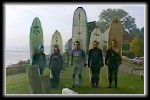 Back in England, a new generation of local surfers began sharing the waves with Lawson and King. And with the access to world communication the internet has offered, the Bore Riders Club was born. An identity for the people that are addicted to the sport, the people you would expect to see on the river on any surfable tide, the people that live their lives around the tides, the Bore Surfers.
Back in England, a new generation of local surfers began sharing the waves with Lawson and King. And with the access to world communication the internet has offered, the Bore Riders Club was born. An identity for the people that are addicted to the sport, the people you would expect to see on the river on any surfable tide, the people that live their lives around the tides, the Bore Surfers.
|
|
Bore Surfing / Coffee Break / E-Mail / Home / Search / Site Map
Site designed by Sabrina. Thanks to everyone that has contributed to the site. |